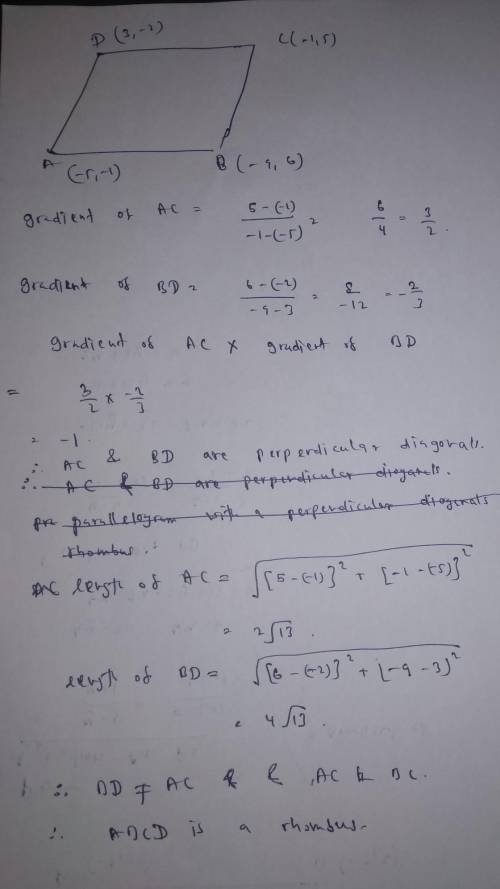
Mathematics, 01.03.2021 14:00 Makoshark6887
Verify that parallelogram ABCD with vertices A(-5, -1), B(-9, 6), C(-1, 5), and D(3, is a rhombus by showing that it is a parallelogram with perpendicular diagonals.


Answers: 1


Another question on Mathematics

Mathematics, 21.06.2019 13:40
Show algebraically that f and g are inverse functions f(x)=x^2/-6; g(x)=square root of 2x+12
Answers: 1

Mathematics, 21.06.2019 19:00
How do the definitions, properties, and postulates you've learned about line segments, parallel lines, and angles to define the shapes of polygons
Answers: 1

Mathematics, 22.06.2019 00:00
This circle is centered at the origin, and the length of its radius is 6. what is the circle's equation? a. x^2+y^2=36 b x^2+y^2=6 c x+y=36 d x^6+y^6=1
Answers: 2

Mathematics, 22.06.2019 00:30
Which ordered pair identifies a point in quadrant iv? a) (2, 5) b) (0, 1) c) (-1, -1) d) (12, -5) which quadrant is (-4,-6) in? a) i. b) ii. c) iii. d) iv.
Answers: 3
You know the right answer?
Verify that parallelogram ABCD with vertices A(-5, -1), B(-9, 6), C(-1, 5), and D(3, is a rhombus by...
Questions


Physics, 09.07.2021 01:00

Mathematics, 09.07.2021 01:00

Mathematics, 09.07.2021 01:00

French, 09.07.2021 01:00

Health, 09.07.2021 01:00


Mathematics, 09.07.2021 01:00


History, 09.07.2021 01:00

Mathematics, 09.07.2021 01:00

Mathematics, 09.07.2021 01:00



Mathematics, 09.07.2021 01:00

English, 09.07.2021 01:00

Mathematics, 09.07.2021 01:00


Mathematics, 09.07.2021 01:00





